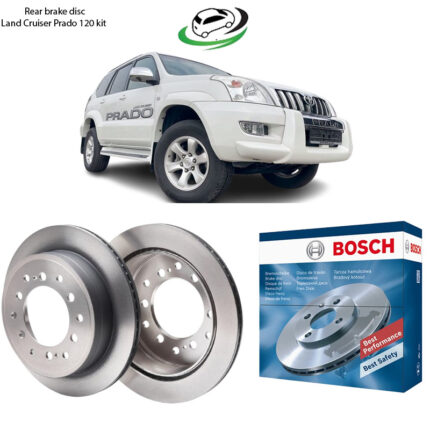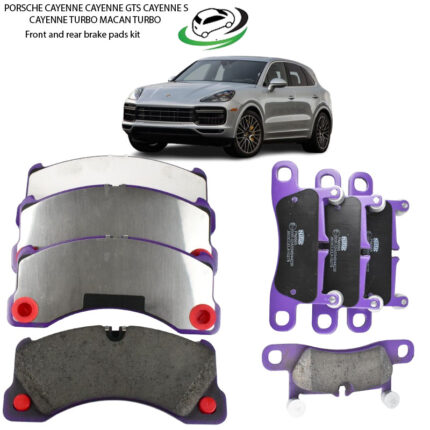-6%
Get Toyota Land Cruiser Prado 120 Series Front Brake Disc 43512-60150
The front brake disc, also known as a rotor, is a critical component of a vehicle’s braking system. It plays an essential role in slowing down and stopping the vehicle by creating friction with the brake pads when the brakes are applied. This guide will delve into the function, structure, materials, benefits, types, installation, maintenance, and signs of wear of front brake discs. Understanding these elements will help you appreciate their importance in ensuring vehicle safety and performance.
What is a Front Brake Disc?
The front brake disc is a flat, circular metal component attached to the wheel hub of a vehicle’s front wheels. When the driver presses the brake pedal, hydraulic pressure pushes the brake pads against the disc, creating friction that slows the rotation of the wheel, ultimately bringing the vehicle to a stop.
The front brake disc is crucial because the front brakes handle approximately 70-80% of the vehicle’s braking force. This is due to the weight transfer that occurs during braking, where the front of the vehicle dips and the rear lifts slightly. As a result, the front brake discs must be durable and capable of dissipating heat generated from repeated braking.
Components of a Front Brake Disc
- Brake Rotor:
- The rotor is the main component of the brake disc. It’s typically made from cast iron, though modern performance vehicles may use high-performance materials such as carbon or ceramic. The rotor works in conjunction with the brake pads to generate the friction necessary to stop the vehicle.
- Brake Pads:
- While not part of the disc itself, brake pads are crucial for the system. They press against the rotor surface when the brakes are applied, creating the friction that slows down the vehicle.
- Caliper:
- The caliper is the component that houses the brake pads and pistons. When the brake pedal is pressed, the pistons in the caliper push the pads against the rotor, initiating the braking process.
- Hub:
- The brake disc is bolted to the wheel hub, which allows the disc to rotate along with the wheel. The hub assembly also plays a role in ensuring the proper alignment and balance of the brake disc.
Functions of the Front Brake Disc
The front brake disc serves several essential functions that contribute to vehicle safety and performance:
- Converts Kinetic Energy to Heat:
- The primary function of the front brake disc is to convert the vehicle’s kinetic energy into heat through friction. As the brake pads clamp down on the disc, the friction generated slows the rotation of the wheel, bringing the vehicle to a stop.
- Dissipates Heat:
- The brake disc must dissipate the heat generated during braking to prevent overheating. High-performance discs are often ventilated or slotted to improve cooling, as overheating can cause brake fade (reduced braking efficiency).
- Maintains Vehicle Stability:
- By providing consistent and reliable braking performance, the front brake discs help maintain vehicle stability during deceleration. This is particularly important in emergency braking situations or when driving at high speeds.
- Ensures Braking Efficiency:
- Front brake discs, especially when paired with quality brake pads, ensure efficient braking. They provide the necessary stopping power for various driving conditions, including city driving, highway cruising, and off-road scenarios.
- Supports Weight Transfer:
- During braking, weight is transferred to the front of the vehicle. The front brake discs must be strong and capable of handling the increased load without warping or cracking.
Benefits of Quality Front Brake Discs
- Enhanced Braking Performance:
- High-quality front brake discs provide superior stopping power, ensuring that the vehicle can stop quickly and safely in a variety of conditions. This is especially important in emergency situations where every second counts.
- Heat Resistance:
- Premium brake discs are designed to resist heat buildup. Ventilated and slotted discs help dissipate heat more efficiently, reducing the risk of brake fade and maintaining consistent braking performance.
- Improved Durability:
- Quality brake discs are made from durable materials like high-carbon iron, which can withstand the rigors of repeated braking without warping, cracking, or suffering from premature wear.
- Noise Reduction:
- Some advanced brake discs feature noise-reducing technologies, such as specially designed slots or patterns that reduce the high-pitched squeal often associated with braking.
- Even Brake Pad Wear:
- Quality discs ensure even contact with the brake pads, which helps reduce uneven pad wear. This not only extends the life of the brake pads but also ensures more consistent braking performance.
- Enhanced Aesthetic Appeal:
- In performance or sport vehicles, certain front brake discs, especially drilled or slotted types, add an aesthetic appeal, giving the vehicle a more aggressive and sporty look.
Types of Front Brake Discs
There are several types of front brake discs, each with unique characteristics that affect performance, durability, and heat dissipation. Choosing the right type of disc depends on the vehicle’s usage, driving conditions, and performance requirements.
- Solid Discs:
- Solid brake discs are the most common type, typically found in standard passenger vehicles. They consist of a single solid piece of metal and are known for their durability and cost-effectiveness. However, they may not dissipate heat as efficiently as ventilated discs, making them more prone to overheating under heavy braking conditions.
- Ventilated Discs:
- Ventilated brake discs have a hollow space between two layers of metal, allowing air to flow through the disc. This design helps dissipate heat more effectively, making ventilated discs a better option for high-performance vehicles or vehicles that require heavy braking, such as trucks or SUVs.
- Drilled Discs:
- Drilled brake discs feature holes drilled into the surface of the rotor. These holes improve heat dissipation and help reduce the risk of brake fade. Drilled discs also allow water to escape, improving braking performance in wet conditions. However, they may be more prone to cracking under extreme heat or heavy loads.
- Slotted Discs:
- Slotted brake discs have shallow grooves cut into the rotor’s surface. These slots help improve braking performance by channeling away heat, gas, and debris that can accumulate between the brake pads and the rotor. Slotted discs are often used in performance vehicles and provide excellent stopping power under extreme conditions.
- Drilled and Slotted Discs:
- Drilled and slotted brake discs combine the benefits of both designs. The drilled holes improve heat dissipation, while the slots channel away debris and gases. These discs are commonly used in high-performance or racing applications where heat management and braking efficiency are critical.
- Carbon-Ceramic Discs:
- Carbon-ceramic brake discs are found in high-end sports cars and racing vehicles. They offer superior performance, excellent heat dissipation, and lightweight construction. However, they are significantly more expensive than traditional iron or steel discs and are typically not necessary for everyday driving.
Installation of Front Brake Discs
Installing front brake discs is a relatively straightforward process, but it requires precision and attention to detail. The following steps outline the general process:
- Raise the Vehicle:
- Use a jack and jack stands to raise the front of the vehicle, ensuring that it is securely supported.
- Remove the Wheels:
- Remove the front wheels to gain access to the brake components.
- Remove the Brake Caliper:
- Use a socket or wrench to unbolt the brake caliper from its mounting bracket. Be sure to support the caliper with a piece of wire or a hook to prevent it from hanging by the brake hose.
- Remove the Old Brake Disc:
- With the caliper removed, the old brake disc should slide off the wheel hub. In some cases, the disc may be held in place by retaining screws, which will need to be removed.
- Install the New Brake Disc:
- Slide the new brake disc onto the wheel hub, ensuring that it is properly aligned with any retaining screws.
- Reinstall the Brake Caliper:
- Reattach the brake caliper, making sure that the brake pads are properly seated against the new disc.
- Replace the Wheels and Lower the Vehicle:
- Reinstall the wheels, tighten the lug nuts, and lower the vehicle back to the ground.
- Test the Brakes:
- Before driving, test the brakes to ensure that everything is functioning correctly.
Maintenance Tips for Front Brake Discs
To ensure optimal performance and longevity, front brake discs require regular maintenance. Here are some tips to keep your discs in top condition:
- Inspect Regularly:
- Check the brake discs during routine maintenance for signs of wear, warping, or cracking. Look for grooves, ridges, or a shiny, glazed surface, which can indicate excessive wear.
- Check for Vibration:
- If you experience a pulsating or vibrating sensation when braking, it may indicate that the brake discs are warped and need to be resurfaced or replaced.
- Avoid Overheating:
- Overheating can cause brake fade and reduce the effectiveness of the discs. Avoid prolonged braking, especially on steep descents, and allow the brakes to cool if you notice a burning smell or reduced braking performance.
- Replace Pads and Discs Together:
- It’s a good idea to replace the brake pads and discs together, as worn pads can cause uneven wear on the discs. Installing new pads with worn discs can also lead to reduced braking performance.
- Keep the Discs Clean:
- Ensure that the brake discs are free of oil, grease, or dirt, as these substances can reduce friction and compromise braking performance.
Signs of Worn Front Brake Discs
- Squealing or Grinding Noise:
- A high-pitched squealing noise when braking can indicate that the brake pads are worn and are causing uneven wear on the brake disc. Grinding sounds typically mean the pads are worn down to the metal, which can cause severe damage to the disc.
- Reduced Braking Performance:
- If your vehicle takes longer to stop or the brake pedal feels soft, it could be a sign that the brake discs are worn or damaged.
- Vibration or Shuddering:
- Warped brake discs can cause the brake pedal to vibrate or the steering wheel to shudder when braking.
- Visible Damage:
- Inspect the brake discs for cracks, grooves, or uneven wear. These are clear signs that the discs need to be replaced.
- Brake Warning Light:
- In some vehicles, a brake warning light may illuminate if there is an issue with the braking system, including worn discs.
Conclusion
The front brake disc is a vital component in a vehicle’s braking system, playing a crucial role in safety and performance. High-quality brake discs, combined with proper maintenance, can provide consistent stopping power, heat dissipation, and durability. Regular inspections and timely replacements will help ensure that your vehicle remains safe on the road, allowing you to enjoy a smooth and reliable braking experience.
Follow us on Facebook for more parts.




Reviews
Clear filtersThere are no reviews yet.